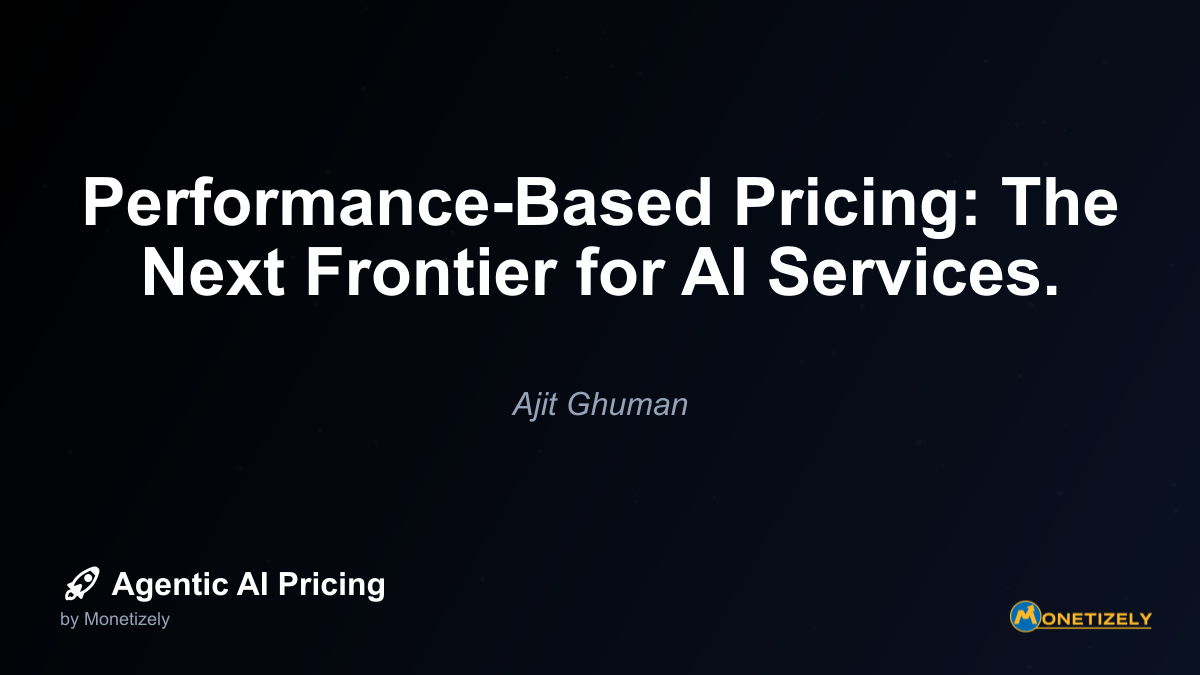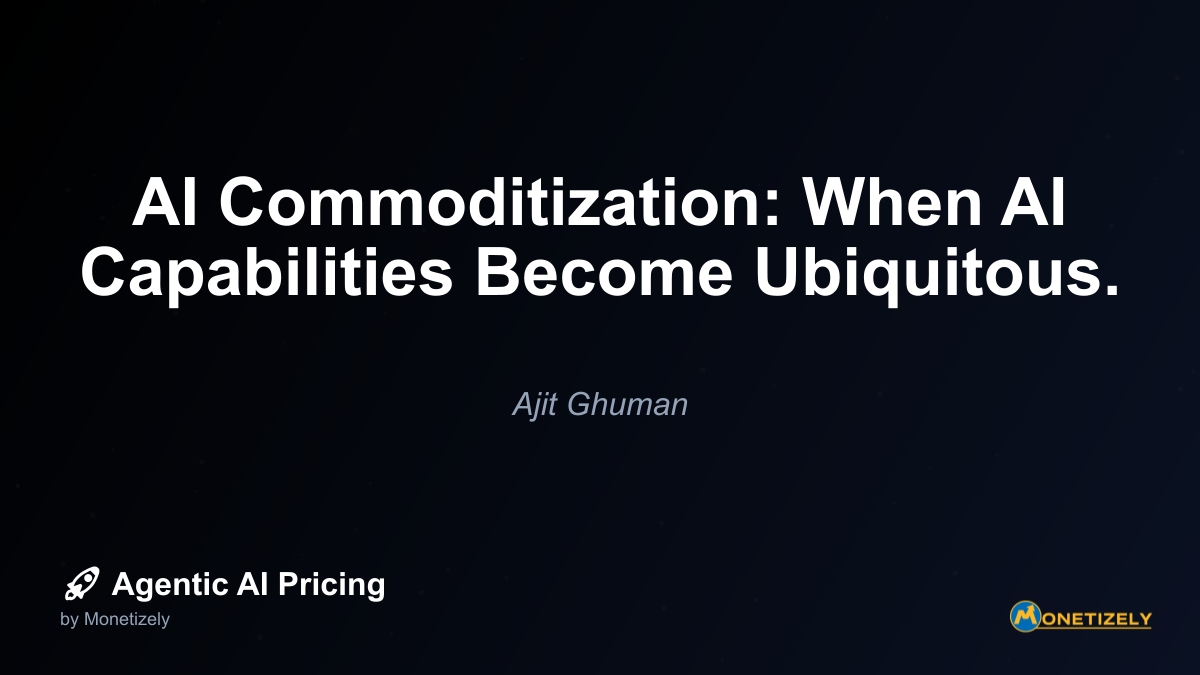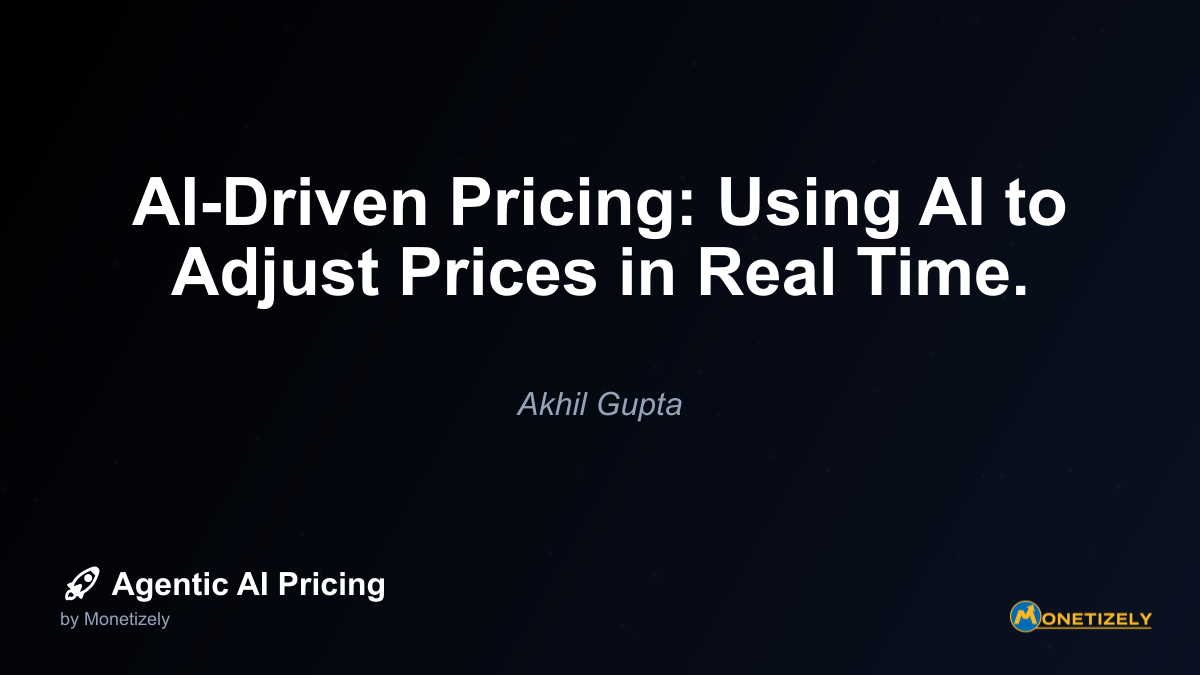· Ajit Ghuman · Emerging Trends · 13 min read
Performance-Based Pricing: The Next Frontier for AI Services.
AI and SaaS Pricing Masterclass
Learn the art of strategic pricing directly from industry experts. Our comprehensive course provides frameworks and methodologies for optimizing your pricing strategy in the evolving AI landscape. Earn a professional certification that can be imported directly to your LinkedIn profile.

Performance-based pricing is emerging as a transformative approach in the AI services landscape, shifting the focus from traditional subscription or usage-based models to one where vendors are compensated based on the measurable business outcomes their AI solutions deliver. This paradigm represents a fundamental evolution in how AI services are valued and monetized, creating stronger alignment between vendors and customers while distributing risk more equitably.
The Evolution of AI Pricing Models
The AI services market has traditionally relied on three primary pricing approaches:
- Subscription-based pricing: Fixed recurring fees regardless of usage or outcomes
- Usage-based pricing: Fees based on consumption metrics like API calls, tokens, or compute resources
- Seat-based licensing: Charging per user with access to the AI system
However, these models face significant limitations in the context of advanced AI services. Subscription models fail to account for varying usage patterns and value creation. Usage-based pricing, while more flexible, can lead to unpredictable costs and doesn’t necessarily correlate with business impact. Seat-based licensing struggles to capture value when AI systems can serve multiple users simultaneously or operate autonomously.
The emergence of performance-based pricing—where vendors charge based on measurable business outcomes—represents a natural evolution as the AI market matures. Recent data indicates this shift is accelerating rapidly, with seat-based pricing dropping from 21% to 15% of companies within a year, while hybrid models (including usage or outcome-based components) surged from 27% to 41%.
What Is Performance-Based Pricing for AI?
Performance-based pricing for AI services is a model where payment is directly tied to the measurable business outcomes achieved by the AI solution. Rather than charging for access, time, or computational resources, vendors receive compensation based on the value they help create.
This approach fundamentally transforms the vendor-customer relationship into a partnership with shared objectives and aligned incentives. When implemented effectively, it reduces customer risk while potentially increasing vendor revenue through a direct connection to value delivery.
Key Characteristics of Performance-Based AI Pricing
- Value-centric: Pricing correlates with actual business value generated rather than inputs or access
- Outcome-driven: Payment depends on achieving predefined measurable outcomes
- Risk-sharing: Vendors share in both the risk and reward of AI implementation
- Transparent measurement: Clear metrics and tracking mechanisms are established upfront
- Aligned incentives: Both parties benefit from optimizing AI performance
The Business Case for Performance-Based Pricing
The shift toward performance-based pricing is driven by compelling business considerations for both AI vendors and their customers.
For AI Vendors
Higher margins: Companies maintaining traditional per-seat models see 40% lower gross margins and over twice the customer churn than those adopting performance-based pricing. Output or token-based pricing can enable gross margins as high as 95%.
Competitive differentiation: Offering performance-based pricing signals confidence in the AI solution’s ability to deliver measurable value.
Customer trust: By assuming some of the implementation risk, vendors build deeper trust with customers.
Longer-term relationships: When pricing is tied to outcomes, vendors have stronger incentives to ensure ongoing customer success, leading to higher retention.
Strategic positioning: Moving beyond commodity pricing to value-based approaches positions vendors as strategic partners rather than technology providers.
For Customers
Reduced risk: Organizations can implement AI solutions with lower upfront investment and financial risk.
Clearer ROI: Performance-based pricing makes the return on AI investments more transparent and measurable.
Vendor accountability: Suppliers have skin in the game and are incentivized to ensure successful outcomes.
Budget justification: Easier to secure budget approval when costs are directly tied to business outcomes.
Scalable investment: As the AI delivers more value, the investment can scale proportionally.
Real-World Implementation Examples
Several organizations have successfully implemented performance-based pricing models for their AI services in recent years. These case studies illustrate the diverse approaches and outcomes possible.
Amazon (AI-Powered Sales Personalization)
Amazon leveraged a performance-driven approach internally by linking AI investments to measurable sales outcomes. While exact pricing details are proprietary, the measured outcomes were impressive:
- 35% increase in qualified leads
- 25% increase in conversion rates
- 17% revenue growth
- 20% increase in sales productivity alongside a 15% reduction in sales costs
- 15% improvement in customer retention and 10% increase in average basket size
The AI tools used, including ThoughtSpot and Invoca, enhanced personalization and customer interaction, enabling a clear value measurement that justified the performance-based pricing model internally.
SuperAGI Clients (AI Sales Agents in Enterprise Tech)
SuperAGI implemented a success-based pricing model combined with subscription or usage fees, where fees correlated to sales performance improvements driven by AI agents. Key metrics and outcomes included:
- 35% rise in demo requests
- 27% increase in proposal submissions
- Sales cycle length reduced from 120 to 90 days (25% reduction)
- 12% decrease in sales and marketing expenses (cost savings approximately $230,000 per quarter)
The AI agents enabled sales teams to focus on high-priority leads, improving efficiency and revenue, with pricing directly tied to these measurable benefits.
Enterprise SaaS Companies Using AI-Driven Dynamic Pricing
By 2025, 65% of enterprise SaaS firms are projected to adopt AI-driven pricing models that blend subscription, usage, and success fees. These models feature:
- AI-driven hyper-personalized value-based pricing that charges customers based on actual value derived from usage patterns and behavioral signals
- Metrics including customer willingness to pay, usage intensity, churn risk, and response to personalized discounts
- Increased revenue maximization through pricing that adjusts dynamically per customer
- Better churn reduction by adjusting prices proactively based on usage patterns and value indicators
Common Performance Metrics in AI Pricing
The effectiveness of performance-based pricing hinges on selecting appropriate metrics that accurately reflect the value created by the AI solution. These metrics vary by industry and use case but generally fall into several categories:
Revenue Impact Metrics
- Incremental revenue generated
- Conversion rate improvements
- Average order value increases
- Upsell/cross-sell success rates
- Customer lifetime value enhancement
Operational Efficiency Metrics
- Cost reduction percentages
- Time saved per process
- Error rate reduction
- Throughput increases
- Resource utilization improvements
Customer Experience Metrics
- Customer satisfaction scores
- Net Promoter Score improvements
- Reduced response times
- First-contact resolution rates
- Churn reduction percentages
Productivity Metrics
- Output per employee
- Tasks automated
- Decision-making speed
- Quality improvements
- Innovation rate increases
The key is selecting metrics that are:
- Clearly attributable to the AI solution
- Objectively measurable
- Aligned with strategic business objectives
- Meaningful to both vendor and customer
Implementation Challenges and Solutions
While performance-based pricing offers significant benefits, implementing it effectively presents several challenges that organizations must navigate.
Challenge 1: Defining Success Metrics
Problem: Selecting appropriate metrics that accurately reflect AI’s contribution to business outcomes can be difficult, especially for complex or novel AI applications.
Solution:
- Conduct collaborative value discovery workshops with clients to understand current performance, pain points, and economic impacts
- Establish baseline metrics before AI implementation to enable accurate measurement of improvements
- Use industry benchmarks and case studies to identify relevant metrics for similar applications
- Create a balanced scorecard of metrics covering different aspects of business impact
Challenge 2: Attribution Issues
Problem: Isolating the AI solution’s specific contribution from other factors affecting business outcomes (market conditions, concurrent initiatives, etc.) is complex.
Solution:
- Implement controlled experiments (A/B testing) to isolate AI impact from other variables
- Use phased rollouts to establish causal relationships between AI implementation and outcomes
- Develop sophisticated analytics to control for external factors
- Agree on attribution methodologies upfront to avoid disputes
Challenge 3: Managing Risk
Problem: Performance-based pricing shifts some risk to the vendor, which must be carefully managed to ensure business viability.
Solution:
- Adopt hybrid pricing models combining a base fee with performance incentives
- Implement trial periods with defined success criteria before full performance-based pricing
- Cap potential downside risk while allowing for upside potential
- Gradually increase the performance-based component as confidence in outcomes grows
Challenge 4: Contract Structuring
Problem: Creating contracts that fairly balance risk, reward, and incentives between parties while remaining legally enforceable is challenging.
Solution:
- Develop clear, unambiguous definitions of all metrics and calculation methodologies
- Include regular review periods to assess and adjust metrics and targets as needed
- Specify dispute resolution mechanisms for disagreements about performance measurement
- Create templates and frameworks that can be customized for different client scenarios
Best Practices for Implementing Performance-Based AI Pricing
Organizations looking to implement performance-based pricing for their AI services should follow these best practices to maximize success:
1. Collaborative Baseline and Target Setting
Start with a thorough understanding of the current state and jointly define what success looks like:
- Conduct value discovery workshops with clients to understand current performance, pain points, and economic impacts
- Establish baseline metrics and jointly define success criteria and improvement targets that justify AI costs
- Document the agreed-upon baseline and targets in clear, measurable terms
2. Value Assessment Tools
Develop tools to forecast and communicate the expected value of the AI solution:
- Create calculators or dashboards that forecast ROI and quantify expected value improvements based on client data and benchmark results
- Use these tools to support sales conversations and align expectations
- Update projections regularly based on actual performance data
3. Value Monitoring Systems
Implement robust systems to track and validate the AI’s impact:
- Integrate with customer platforms to capture real-time performance data
- Enable continuous tracking and validation of the AI’s impact
- Schedule regular review meetings to discuss results and refine solutions
4. Flexible Contract Structures
Design contracts that balance predictability with performance incentives:
- Include a base subscription or implementation fee to cover fixed costs
- Add variable fees tied to performance metrics, such as incremental revenue or error reduction
- Specify clear measurement approaches and define how value is calculated
- Incorporate risk-sharing mechanisms, such as performance guarantees or refund clauses if targets are not met
5. Continuous Improvement Framework
Build mechanisms to incentivize ongoing enhancement of the AI solution:
- Use tiered pricing based on output quality or outcome levels
- Implement regular performance reviews with improvement targets
- Share insights and best practices to help clients maximize value
- Invest in AI capabilities that directly impact the performance metrics
Industry-Specific Applications and Considerations
Performance-based pricing models must be tailored to the specific characteristics and requirements of different industries. Here’s how this approach can be applied across various sectors:
Healthcare
Key metrics: Treatment outcome improvements, readmission reductions, diagnostic accuracy, operational efficiency, cost savings
Considerations:
- Regulatory compliance and patient privacy concerns may limit data access
- Multiple stakeholders (providers, payers, patients) with different value perceptions
- Long-term outcomes may be difficult to attribute solely to AI
Example application: AI diagnostic tools priced based on improvement in early detection rates or reduction in unnecessary tests.
Financial Services
Key metrics: Fraud detection rates, investment performance, customer acquisition costs, process automation savings, risk assessment accuracy
Considerations:
- Highly regulated environment with strict compliance requirements
- Risk management is paramount, requiring robust validation
- Seasonal and market fluctuations affect performance metrics
Example application: AI-powered trading algorithms charging a percentage of outperformance versus benchmark indices.
Retail and E-commerce
Key metrics: Conversion rate improvement, average order value increase, inventory optimization, customer retention, personalization effectiveness
Considerations:
- Seasonal variations in sales and customer behavior
- Competitive landscape changes rapidly
- Multiple touchpoints make attribution complex
Example application: Product recommendation engines charging based on incremental sales directly attributed to recommendations.
Manufacturing
Key metrics: Predictive maintenance success, production efficiency, quality improvement, supply chain optimization, energy savings
Considerations:
- Long asset lifecycles affect ROI timeframes
- Safety and reliability concerns are paramount
- Integration with legacy systems may be challenging
Example application: Predictive maintenance AI priced based on reduction in unplanned downtime or maintenance cost savings.
The Future of Performance-Based Pricing in AI
As AI technology and the market continue to evolve, performance-based pricing models are expected to become more sophisticated and widespread. Several key trends are likely to shape this evolution:
1. Hybrid Pricing Models
The future will likely see increasing adoption of hybrid models that combine elements of different pricing approaches:
- Base subscription or implementation fees to cover fixed costs
- Usage-based components for variable resource consumption
- Performance-based elements tied to specific business outcomes
- Tiered pricing based on value delivered or complexity of use cases
This balanced approach helps mitigate risk while maintaining the alignment benefits of performance-based pricing.
2. Outcome-Based Tiering
Pricing will increasingly be structured around tiers based on the level or quality of outcomes achieved:
- Basic tier: Core functionality with minimal guarantees
- Performance tier: Enhanced features with moderate outcome commitments
- Premium tier: Full capabilities with ambitious performance targets
- Custom tier: Tailored solutions with negotiated outcome metrics
This approach allows customers to select the level of risk and reward that best suits their needs while providing clear upgrade paths.
3. Advanced Value Tracking
Technological advances will enable more sophisticated tracking and attribution of AI’s impact:
- AI-integrated dashboards providing real-time performance visibility
- Automated monitoring tools making measurement more transparent
- Blockchain-based verification of outcomes for increased trust
- Sophisticated attribution models accounting for multiple variables
These capabilities will reduce disputes and increase confidence in performance measurements.
4. Broader Adoption
As trust increases and methodologies mature, performance-based pricing will expand across more industries and use cases:
- Industry benchmarks and case studies will provide reference points
- Standardized frameworks will emerge for common applications
- Risk assessment models will become more sophisticated
- Vendor confidence will grow as success patterns become clearer
This expansion will accelerate as early adopters demonstrate competitive advantages.
5. Economic Impact
Research suggests that performance-based pricing models tend to yield higher ROI and stronger vendor-customer alignment:
- McKinsey reports a 32% improvement in ROI for performance-based AI implementations
- Vendors report 40% higher gross margins compared to traditional pricing models
- Customer churn rates are typically less than half when using outcome-based pricing
- Implementation success rates improve by 25-30% with aligned incentives
These economic benefits will drive further adoption and innovation in performance-based pricing.
How Major AI Providers Are Approaching Performance-Based Pricing
Leading AI service providers are taking varied approaches to performance-based pricing, with some embracing elements of the model while others remain cautious.
OpenAI
OpenAI primarily uses a token-based, pay-as-you-go model charging per 1,000 tokens processed, aligning costs closely with computational usage. Their pricing varies by model (e.g., GPT-4o at about $0.03 per 1,000 input tokens) and offers both startup-friendly free trial credits and enterprise plans with custom pricing.
While not explicitly implementing outcome-based pricing, OpenAI’s approach aligns with the broader industry trend toward exploring charging per measurable business outcome. Their enterprise offerings often include custom pricing that can incorporate performance elements for large-scale implementations.
Microsoft
As a major investor and partner of OpenAI, Microsoft integrates AI features like Copilot into Microsoft 365 subscription plans. Unlike pure usage-based fees, Microsoft has raised subscription prices reflecting the embedded AI value, blending flat-rate and value-based models.
This suggests a strategic willingness to absorb AI costs into broader product pricing, with no clear public indication of performance-based pricing tied to outcomes. However, for enterprise customers, Microsoft offers custom pricing arrangements that may include performance components.
Google combines AI capabilities into Workspace and other Cloud services, recently embedding AI at no additional direct cost by adjusting overall pricing. This reflects a strategy to make AI “table stakes” within their broader service offerings.
Their pricing tends to be more traditional, relying on flat-rate or usage fees rather than outcome-based pricing, but continues to evolve as AI adoption expands. For large enterprise implementations, Google Cloud offers custom pricing that may incorporate performance elements.
Salesforce
Salesforce often leverages AI as a value-add within its CRM and Cloud software suites. Their pricing typically bundles AI features into tiered subscriptions, with custom enterprise deals reflecting usage scale and additional services.
Salesforce and similar enterprise software firms are among those experimenting with outcome-based pricing models, such as charging per sales meeting booked via AI assistants or support tickets resolved by AI. While still nascent, these approaches represent early steps toward more sophisticated performance-based pricing.
Strategic Decision Framework for Adopting Performance-Based Pricing
Organizations considering performance-based pricing for their AI services should follow a structured decision framework to determine if and how to implement this approach.
1. Value Assessment
Begin by thoroughly understanding the value your AI solution creates:
- Identify all potential value drivers (revenue impact, cost savings, risk reduction, etc.)
- Quantify the expected magnitude of these benefits based on existing data
- Assess the timeframe for realizing these benefits
- Determine how directly your solution contributes to these outcomes
2. Metric Selection
Choose appropriate performance metrics based on the value assessment:
- Select metrics that directly reflect the value created
- Ensure metrics are objectively measurable and difficult to manipulate
- Consider both leading indicators (early signals) and lagging indicators (final outcomes)
- Limit the number of metrics to maintain focus and clarity
3. Risk Analysis
Evaluate the risks associated with performance-based pricing:
Co-Founder & CEO
Ajit is the author of Price To Scale, a top book on SaaS Pricing and is the Founder of Monetizely. Ajit has led and worked in pricing and product marketing at firms like Twilio, Narvar and Medallia. His work has been featured in Forbes and VentureBeat. Ajit regularly consults with software companies from Seed stage to post-IPO on pricing strategy. Ajit is also a highly-rated co-instructor for 'The Art of SaaS Pricing and Monetization' on Maven.
Pricing Strategy Audit
Let our experts analyze your current pricing strategy and identify opportunities for improvement. Our data-driven assessment will help you unlock untapped revenue potential and optimize your AI pricing approach.




